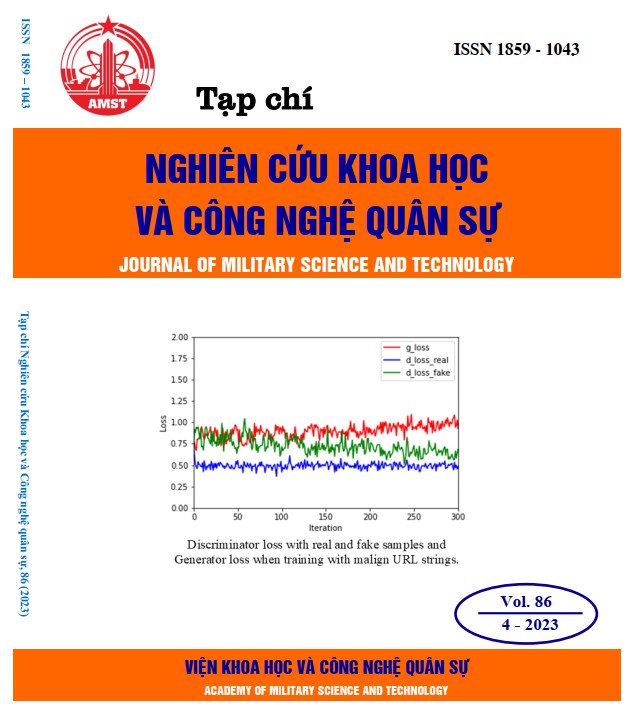Improving the image quality of optical systems with radially symmetrical phase mask
317 viewsDOI:
https://doi.org/10.54939/1859-1043.j.mst.86.2023.95-102Keywords:
Optical system; Depth of field; Radially symmetrical phase mask.Abstract
An optical system with a radially symmetrical phase mask allows to extend the depth of field. However, the contrast of the optical system is still lower than that of the diffraction pattern of the traditional optical system. In this paper, we introduce a new method for image enhancement of optical systems with radially symmetric phase masks. The optical system with a traditional radial symmetric phase mask would result in a dot point spread function. The optical system with an improved symmetric phase mask results in a dark center point spread function. The two images that will be obtained correspond to the optical system with two phase masks. On the basis of these two images, a mathematical relationship is proposed in order to obtain good quality images. The simulation results have demonstrated the proposed method to improve the image quality of the optical system with the radial symmetrical phase mask.
References
[1]. E. R. Dowski, Jr. and W. T. Cathey, “Extended depth of field through wave-front coding,” Appl. Opt. 34, pp.1859–1866, (1995). DOI: https://doi.org/10.1364/AO.34.001859
[2]. H. Zhao and Y. Li, “Optimized sinusoidal phase mask to extend the depth of field of an incoherent imaging system,” Opt. Lett. 35, pp.667–669, (2010). DOI: https://doi.org/10.1364/OL.35.000267
[3]. H. Zhao and Y. Li, “Optimized logarithmic phase masks used to generate defocus invariant modulation transfer function for wavefront coding system,” Opt. Lett. 35, pp.2630–2632, (2010). DOI: https://doi.org/10.1364/OL.35.002630
[4]. V. Le, S. Chen, and Z. Fan, “Optimized asymmetrical tangent phase mask to obtain defocus invariant modulation transfer function in incoherent imaging system,” Opt. Lett. 39, pp.2171–2174, (2014). DOI: https://doi.org/10.1364/OL.39.002171
[5]. Q. Yang, L. Liu, and J. Sun, “Optimized phase pupil masks for extended depth of field,” Opt. Commun. 272, pp.56–66, (2007). DOI: https://doi.org/10.1016/j.optcom.2006.11.021
[6]. N. Caron and Y. Sheng, “Polynomial phase mask for extending depth-of-field optimized by simulated annealing,” Proc. SPIE 6832, 68321G, (2007). DOI: https://doi.org/10.1117/12.754805
[7]. S. Mezouari and A. R. Harvey, “Phase pupil functions for reduction of defocus and spherical aberrations,” Opt. Lett. 28, pp.771–773, (2003). DOI: https://doi.org/10.1364/OL.28.000771
[8]. J. Sochacki, S. Bará, Z. Jaroszewicz, and A. Kołodziejczyk, “Phase retardation of uniform-intensity axilens,” Opt. Lett. 17, pp.7–9, (1992). DOI: https://doi.org/10.1364/OL.17.000007
[9]. D. Zalvidea and E. E. Sicre, “Phase pupil functions for focal depth enhancement derived from a Wigner distribution function,” Appl. Opt. 37, pp.3623–3627, (1998). DOI: https://doi.org/10.1364/AO.37.003623
[10]. W. Chi, N. George, “Electric imaging using a logarithmic asphere,” Opt. Lett. 26, pp.875–877, (2001). DOI: https://doi.org/10.1364/OL.26.000875
[11]. M. Demenikov and A. R. Harvey, “Parametric blind-deconvolution algorithm to remove image artifacts in hybrid imaging systems,” Opt. Express 18, 18035–18040, (2010). DOI: https://doi.org/10.1364/OE.18.008207
[12]. V. Le, Z. Fan, and Q. Duong, “To extend the depth of field by using the asymmetrical phase mask and its conjugation phase mask in wavefront coding imaging systems,” Appl. Opt. 54, 3630–3634, (2015). DOI: https://doi.org/10.1364/AO.54.003630
[13]. S. Chen, V. Le, Z. Fan, and H. Cam, “Extended depth-of-field imaging through radially symmetrical conjugate phase masks,” Opt. Eng. 54, 115103, (2015). DOI: https://doi.org/10.1117/1.OE.54.11.115103







